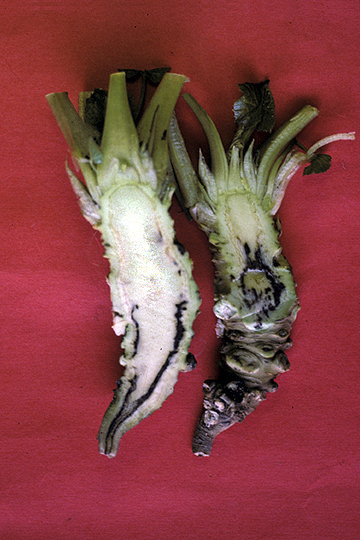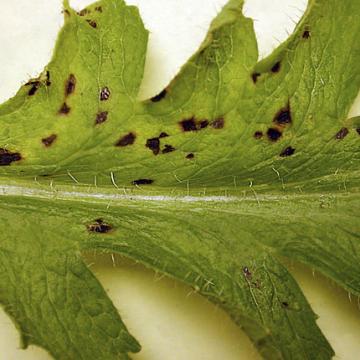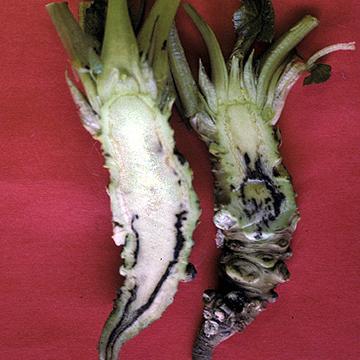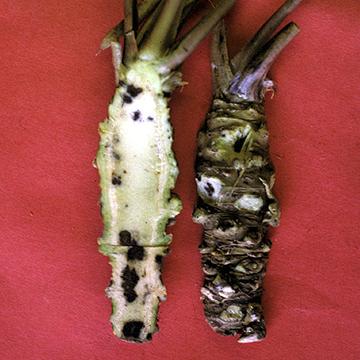DISEASE: Bacterial blight
HOST: Poppy
The disease begins with water-soaked lesions that turn brown to black. They may be surrounded by a translucent ring. Buds, leaves, flowers, and pods are affected.

Bacterial blight | Poppy
DISEASE: Bacterial blight
HOST: Poppy (Eschscholzia californica)
PATHOGEN: Xanthomonas campestris pv. papavericola
SOURCE: M. Daughtrey
DISEASE: Bacterial soft rot
HOST: Orchid
Oncidium orchid with translucence and rot of central leaves.

Bacterial soft rot | Orchid
DISEASE: Bacterial soft rot
HOST: Orchid (Oncidium sp.)
PATHOGEN: Pectobacterium carotovorum
PATHOGEN SYNONYM: Erwinia carotovora subsp. carotovora
SOURCE: R. McMillan
DISEASE: Bacterial soft rot
HOST: Wasabi (Japanese horseradish)
Longitudinal sections of diseased rhizomes with discolored vascular tissues.

Bacterial soft rot | Wasabi (Japanese horseradish)
DISEASE: Bacterial soft rot
HOST: Wasabi (Japanese horseradish) (Wasabia japonica)
PATHOGEN: Pectobacterium wasabiae
PATHOGEN SYNONYM: Erwinia carotovora subsp. wasabiae
SOURCE: M. Goto
DISEASE: Bacterial soft rot
HOST: Wasabi (Japanese horseradish)
Longitudinal section of rhizome with discolored vascular bundles (left), and rhizome with external symptoms (right).

Bacterial soft rot | Wasabi (Japanese horseradish)
DISEASE: Bacterial soft rot
HOST: Wasabi (Japanese horseradish) (Wasabia japonica)
PATHOGEN: Pectobacterium wasabiae
PATHOGEN SYNONYM: Erwinia carotovora subsp. wasabiae
SOURCE: M. Goto
DISEASE: Bacterial soft rot
HOST: Wasabi (Japanese horseradish)
Cross section of rhizome with dark, infected vascular bundles.

Bacterial soft rot | Wasabi (Japanese horseradish)
DISEASE: Bacterial soft rot
HOST: Wasabi (Japanese horseradish) (Wasabia japonica)
PATHOGEN: Pectobacterium wasabiae
PATHOGEN SYNONYM: Erwinia carotovora subsp. wasabiae
SOURCE: G. Rodriguez
DISEASE: Bacterial stem rot
HOST: Orchid
Oncidium orchid with rot at base of stem.

Bacterial stem rot | Orchid
DISEASE: Bacterial stem rot
HOST: Orchid (Oncidium sp.)
PATHOGEN: Burkholderia andropogonis
PATHOGEN SYNONYM: Pseudomonas andropogonis
SOURCE: A. Alvarez









